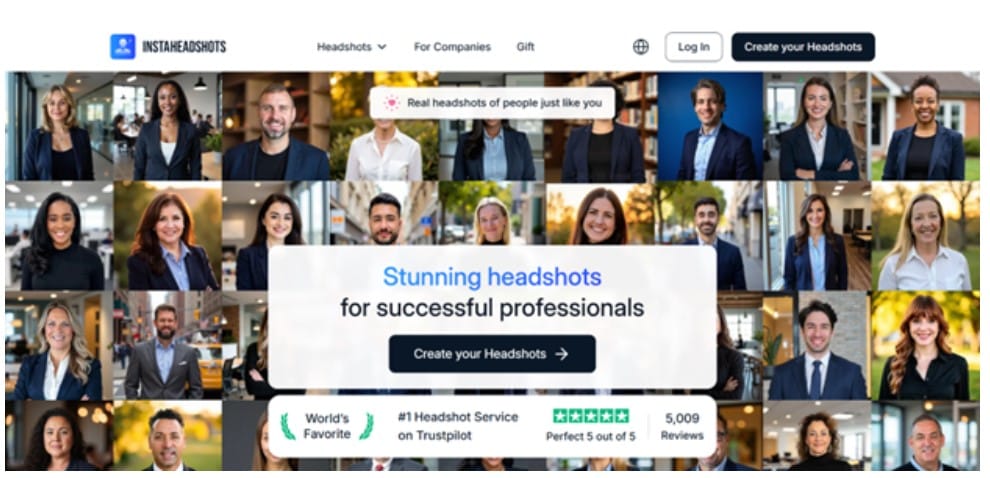Align your corporate headshot strategy with brand identity
Before anyone steps in front of a camera—or feeds selfies into an AI tool—pause and ask, What should our corporate headshots say about us?
Identify two or three traits your clients prize most, such as ingenuity, reliability, or warm customer care. Those words will steer every creative choice, from lighting to wardrobe, and anchor your search visibility around “corporate headshots” and “brand identity.”
Turn values into visuals. A fintech that champions openness might choose bright, airy portraits with hints of brand color, while a law firm known for steadiness could opt for classic studio light and darker suits. When style mirrors a story, prospects sense the fit instantly.
Document the decisions in a one-page Headshot Style Guide: background hue, crop, wardrobe do’s and don’ts, acceptable expressions. Keep it simple so a new hire on the other side of the world can follow it on day one. Consistency matters—68 % of consumers say they trust a brand more when its presentation is uniform (HappyRichGuy.com).
Peek at competitor sites for a gut check. If everyone shows playful outdoor shots, crisp studio portraits will help you stand out; if the field feels stiff, a friendlier vibe can be the breath of fresh air.
Finally, think across channels. These photos will live beside your logo, fonts, and slide decks. When every touchpoint is in tune, prospects recognize an organized, confident brand before they read a single testimonial.
Get the strategy right now and later steps—clothes, lighting, production—fall neatly into place, keeping each smile, backdrop, and pixel pointed in the same direction.

Dress and prepare for headshot success
Clothing speaks before you do. Ask teammates to dress as they would for a client they want to impress—confident, tidy, and unmistakably on-brand.
Choose solids over fine patterns. Pinstripes and tight checks can create distracting moiré ripples on camera; solid fabrics or large, irregular prints photograph cleanly. Encourage touches of brand color – a navy jacket, a muted red scarf, or a pocket square – so the palette echoes your website.
Grooming counts. Freshly trimmed hair (or neatly styled curls), tame facial hair, and a light dusting of powder keep shine in check. Makeup wearers can aim for “natural plus”: neutral tones that even skin and define eyes without glitter that bounces flash back at the lens.
Pose with presence. A slight turn of the shoulders, relaxed posture, and a gentle forward lean signal warmth and engagement; according to Psychology Today, studies link that lean to higher first‑impression likability.
Create a calm set. Soft background music, a mirror within reach, and five‑minute buffers between slots help people settle in. Showing a quick preview frame melts nerves and sparks authentic smiles.
Night‑before reminder (keep it simple):
- Two wrinkle‑free outfit options
- Hydrate, and rest
- Oil‑blotting sheets or powder for shine
A few minutes of prep deliver stress‑free sessions and photos that project the trust your brand relies on.
Choose your production method
Work with a professional photographer
Nothing builds confidence like a seasoned photographer behind the lens. In the United States, a traditional headshot session now averages $250 to $265 and delivers one to three fully retouched images within a week or two, according to StudioShot.ai. You pay for eyes that spot stray collar points, shape flattering light, and keep retouching natural, all crucial when those faces appear in media kits, keynote decks, and press coverage.
Use an AI headshot generator
When speed or geography makes scheduling tough, AI can help. A 2025 Harris Poll reported by PhotoPacks.ai found that 44 % of Americans—and 55 % of millennials—would consider AI‑created headshots because of cost and convenience. Upload a handful of selfies and, within an hour, receive dozens of studio‑style options. Quality still hinges on clear source photos, but modern models reproduce realistic skin texture and lighting that most viewers—including recruiters—cannot tell from a studio shot, according to Staffing Industry News.
Blend studio shots and AI for the best of both worlds
Many brands split the difference: commission a photographer for high‑visibility executives, then use AI for distributed teams or quick refreshes. This approach trims budget without sacrificing polish, so leaders get hand‑retouched portraits while new hires appear on‑brand within 24 hours.
Whichever path you choose, align every image with the Headshot Style Guide you set in Step 1 so backgrounds, crops, and color temperature stay consistent.
Seasoned photographers bring more than a good camera: they shape light, direct expression, and retouch just enough to keep skin real. The difference shows up in the final pixel and in the confidence your team carries into client calls.
Cost varies by market, but a 2025 survey of 1,200 United States studios puts the median corporate‑headshot session at $250 to $265, including one to three retouched images delivered within two weeks, according to StudioShot.ai. For leaders whose faces anchor pitch decks and media kits, that investment buys:
- A built‑in creative director who scouts backgrounds and aligns every frame with your Headshot Style Guide.
- Professional retouching that removes lint and blemishes without “plastic skin.”
- A calm, efficiently run set that signals to employees their image, and time, matter.
The result is a cohesive gallery that looks trustworthy the moment it loads on your site. If budgets are tight, reserve studio time for high‑visibility roles, and complement the rest of the team with AI headshots in the next section.
Best AI Headshot Generators Compared (2025)
The market for AI‑generated corporate portraits has matured quickly, but five platforms still stand out for reliability, realism, and brand‑readiness.
InstaHeadshots — Best overall for realism and speed.

InstaHeadshots uses a training set of millions of studio portraits, allowing its algorithm to replicate the soft, directional lighting and authentic skin texture you’d expect from a high‑end photographer. Upload a dozen clear selfies and, in well under an hour, you receive more than a hundred options spanning subtle outfit changes, on‑brand background hues, and a range of expressions. Data handling is GDPR‑compliant and files are auto‑deleted after delivery, so large enterprises can roll the service out worldwide with minimal risk. Many users report that colleagues cannot tell the difference between these images and an in‑studio shot—making InstaHeadshots the go‑to when you need premium quality at scale.
BetterPic — Most customizable for strict brand guidelines.

If your headshot style guide specifies an exact Pantone background or allows only a narrow palette of clothing colors, BetterPic lets you dial in precise RGB or HEX values before final rendering. After processing, you can tweak retouch intensity, swap suit colors, and even adjust focal length to match existing leadership portraits. The interface skews toward power users, but the ability to micro‑adjust each detail makes BetterPic invaluable to design‑driven companies that want every pixel to scream “on‑brand.”
Aragon AI — Best for sheer variety of usable poses.

Aragon AI’s engine emphasizes diversity of output: a typical batch yields 40‑plus poses—straight‑on, three‑quarter, and candid‑style—across multiple background settings. Remote teams appreciate this because each employee is more likely to find a frame that genuinely reflects their personality, which in turn boosts confidence when posting the image on public profiles. Reviewers note that a handful of results may need minor clean-up (occasional eye asymmetry or stray hair), but the breadth of choice offsets the extra curation time.
HeadshotPro — Enterprise workhorse for large‑team rollouts.

HeadshotPro focuses on operational efficiency: an admin dashboard accepts bulk CSV uploads, assigns license credits, and spits out a uniform grid of portraits that share identical framing and backdrop. HR departments at Fortune 500 brands use the platform to onboard hundreds of hires each quarter without booking a single photographer. The visual quality is solid—slightly less cinematic than InstaHeadshots but more than acceptable for LinkedIn, slide decks, and press releases—and per‑seat pricing drops sharply at volume.
TryItOnAI — Budget‑friendly gateway tool.

Priced under $20, TryItOnAI is the lowest‑risk way for individuals or micro‑firms to test the AI‑portrait waters. Turnaround can be as fast as 30 minutes, and while you’ll only get about 20 final frames, at least a handful usually pass muster for social profiles or small‑business “About Us” pages. The platform offers fewer style presets and weaker fine‑tuning than the higher‑tier tools, but its convenience and price make it perfect for quick refreshes or experimenting before a broader rollout.
Pro tip: Regardless of platform, feed the algorithm 10–15 well‑lit, high‑resolution selfies shot against plain backgrounds. This maximizes facial fidelity and minimizes post‑production clean‑up.
Keep headshots consistent, authentic, and current Keep headshots consistent, authentic, and current
Consistency is commercial. A Lucidpress survey reported by Business Insider found that brands presenting themselves uniformly across channels see up to 33 percent higher revenue than those that do not. Start by fixing three variables:
Visual harmony. Lock a single background, crop ratio, and color temperature in your Headshot Style Guide. Whether images come from a studio or an AI engine, reject any shot that strays. Visitors may not pinpoint the reason, but they will feel the difference.
Real faces, not plastic ones. Retouch lint, flyaways, and yesterday’s blemish, then stop. Leave laugh lines and freckles intact; over-smoothing erodes trust.
Built-in refresh cycles. Styles, glasses, and hairstyles change. Schedule a two-year refresh for the wider team and an annual shoot for executives in the spotlight. AI supports quick updates: upload new selfies, match the backdrop, and replace files before the next stakeholder meeting.
Finish with tidy ops: standardize file names (Company-Firstname-Lastname.jpg) and resolutions. A clean library saves PR teams hours when a journalist needs art at 4 p.m., and keeps your visual story sharp every time it appears.
Put headshots to work in PR and marketing
A headshot has no value when it sits in a shared drive; it delivers when those faces greet prospects, journalists, and partners across every touchpoint.
Website. The About or Team page is often a visitor’s next click after the homepage. According to Boomtime, 52 percent of B2B buyers look their first to judge credibility. Replace stock art with real, on-brand portraits to lift engagement and strengthen PR headshot consistency.
Media kit. Reporters appreciate ready-to-run assets. Include leadership headshots (print-resolution PNG and JPEG) in your media kit with every release. The easier you make their job, the more often they feature your story—complete with the image you control.
LinkedIn. Encourage staff to upload their new headshots the week they appear on your site. A grid of matching portraits sends a quiet, persuasive signal that your company is unified and professional.
Internal and investor comms. Spotlight new hires in the newsletter, pair executive photos with quarterly updates, and add faces to org-chart tools. Familiarity nurtures camaraderie and, over time, retention.
Track the lift. Compare About-page dwell time and LinkedIn profile views before and after the refresh. Log anecdotal wins (“Loved your team photos,” says a prospect). Whether the numbers are large or small, they confirm what research already suggests: people trust the people they can see.
Conclusion
Corporate headshots are far more than profile pictures—they’re visual proof of your brand’s promise. When your team’s photos align with core values, look consistently polished across channels, and stay refreshingly current, you create an instant layer of trust that underpins every PR, marketing, and sales initiative. Whether you invest in a professional photographer, tap an AI tool like InstaHeadshots, or blend both approaches, the key is to keep authenticity at the center. A confident smile that truly represents the person behind it is still the most powerful brand asset money can buy.
Frequently Asked Questions (FAQ)
How often should corporate headshots be updated?
Plan a refresh every two years, or sooner if a person’s appearance changes noticeably or your brand undergoes a visual re‑launch.
How many source photos should I upload to an AI headshot generator?
Most services recommend 10–15 clear selfies taken in varied lighting and angles. The more variety you provide, the more accurately the AI can replicate your features and avoid artifacts.
Are AI‑generated headshots acceptable on professional platforms like LinkedIn?
Yes—provided the image looks realistic, aligns with LinkedIn’s photo guidelines, and genuinely represents your current appearance. Avoid overly air‑brushed results that could undermine credibility.
Is it safe to upload selfies to an AI headshot service?
Use providers that outline strong data‑protection practices (e.g., GDPR compliance, encrypted uploads, automatic deletion after processing). Always review the privacy policy before submitting photos.



